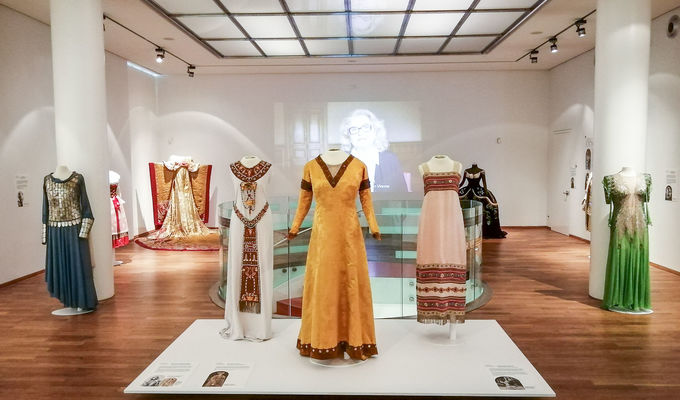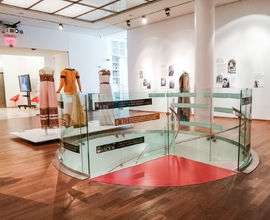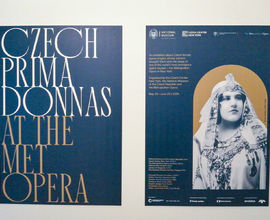Showcasing unique theater costumes from the collections of the National Museum of the Czech Republic and the Metropolitan Opera and much more, the exhibition presents famous Czech singers from the beginning of the 20th century until the present day. During their careers, these singers performed in one of the world’s most prestigious opera houses, The Metropolitan Opera, and were often instrumental in the performances of important Czech operas.
Using authentic photographs, and, most of all, original costumes from the collections of the National Museum of the Czech Republic and the Metropolitan Opera, visitors to the Gallery of the Czech Center New York have the opportunity to get to know the art, achievements and roles of Emmy Destinn, Maria Jeritza, Maria Müller, Jarmila Novotná, Ludmila Dvořáková, Eva Randová, Gabriela Beňačková, Eva Urbanová and, most recently, Magdalena Kožená.
The exhibits include Emmy Destinn’s costumes in which she appeared during her tenure at the Metropolitan Opera: as Alice Ford in Verdi’s Falstaff (1909) and Aida in Verdi’s eponymous opera, which happened to have been Destinn’s debut at the Met in 1908. Visitors will also enjoy imitation jewelry for her Pamina costume from Mozart’s The Magic Flute. Owned by the singer and originally intended for the role of Aida performed at the court opera in Berlin, the unique accessories were used by Destinn in other opera productions as well. The Metropolitan Opera Archive provided the costume of Maria Jeritza from Puccini’s Turandot (1926) as well as costumes of Mařenka (B. Smetana: The Bartered Bride, 1941) and Violetta (G. Verdi: La traviata, 1940) worn by Jarmila Novotná. The exhibition also include video interviews with contemporary Czech female singers, archival images from the collections of the Czech National Film Archive as well as accompanying texts with reproductions of period photographs.
Some of the opera singers, whose costumes and accessories are on display, performed at the Metropolitan Opera in the first productions of important Czech operas, including Emmy Destinn, who performed at the Met under the baton of Gustav Mahler as the very first Mařenka in Smetana’s The Bartered Bride (1909), or Maria Jeritza, who appeared in the American premiere of Janáček’s Jenůfa (1924) and was the first in the history of this opera house to star as Puccini’s Turandot (1926). During her tenure at the Met, she played 20 roles in a total of 345 performances. In addition to New York and Vienna, she performed on numerous stages around the world in the course of her career, including Prague, London, France, Sweden, Denmark, Hungary, Russia and other countries. Thanks to her powerful voice, she was nicknamed the “Moravian Thunder”.
Emmy Destinn, mentioned above, was another Puccini singer, having played the lead role in the world premiere of his opera La Fanciulla del West (1910) alongside Enrico Caruso. Emmy Destinn was a prima donna of the Deutsche Oper Berlin, where she appeared in fifty roles over the course of ten years. She also gave concerts in Czechoslovakia, the UK and Yugoslavia.
Maria Müller starred in the lead role in the premiere of Jaromír Weinberger’s Czech opera Švanda the Bagpiper (1931) and also appeared in several other world opera premieres at the Met. Another important singer was Jarmila Novotná, who had her own costume made for her performances as Violetta in Verdi’s La traviata (1940) at the Prague salon of Hana Podolská. She also enjoyed success as a film actress and published her memoirs towards the end of her life.
Gabriela Beňačková, the first performer of Dvořák’s Rusalka (1993), and also the first Janáček’s Káťa Kabanová on this stage (1991), is another prominent singer. In 1999, she ended up having a total of 39 Met performances under her belt and was inducted into the Czech National Theater Hall of Fame in 2017.
Among the female singers currently active, Eva Urbanová performed at the Metropolitan Opera, as, among others, the Foreign Princess in Dvořák’s Rusalka (2004), and most recently Magdalena Kožená as Varvara in Káťa Kabanová (2004). Several Czech female singers performed at the Met before the fall of the Iron Curtain: Ludmila Dvořáková in the 1960s in predominantly Wagnerian roles, and Eva Randová in the 1980s and late 1990s, who starred not only in Wagner’s operas, but also as Janáček’s Kabanicha (1999). The singers performed under the baton of renowned conductors including Gustav Mahler, Arturo Toscanini, Artur Bodanzky, Bruno Walter, Sir Charles Mackerras, James Levine, Jiří Bělohlávek and Sir Simon Rattle. Their singing partners included the equally well-known likes of Enrico Caruso, Karel Burian, Leo Slezak, Pavel Ludikar, Leonie Rysanek and Karita Mattila.
The Metropolitan Opera was founded in 1883 as an alternative to the already existing Opera Music House. With a capacity of 3,800, it is one of the largest opera houses in the world. Run by a non-profit organization supported by prominent personalities, it presents around 220 performances every year, mainly classical operas by major composers with the biggest opera stars and spectacular sets and production designs.
Metropolitan Opera performances have been broadcast live on radio since 1931, on television since 1977, and, in recent years, also in cinemas around the world.
The Czech Prima Donnas at the Met Opera exhibition will be on view at the Gallery of the Czech Center New York until June 23.





